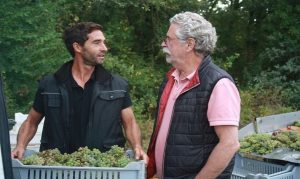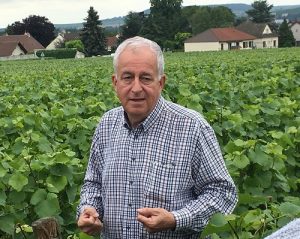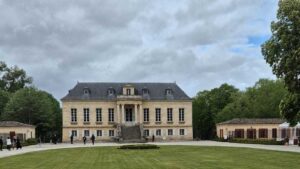 Jacky Blot has been producing brilliant white wines in Montlouis and Vouvray at his Domaine de la Taille aux Loups estate for more than 30 years (the first vintage was in 1990). And since 2002, he has been creating excellent Cabernets Francs after taking over a domain found on the hills of Bourgueil. Join us as we discover Domaine de La Butte, where he works with his son Jean-Philippe, and its truly delicious cuvées.
Jacky Blot has been producing brilliant white wines in Montlouis and Vouvray at his Domaine de la Taille aux Loups estate for more than 30 years (the first vintage was in 1990). And since 2002, he has been creating excellent Cabernets Francs after taking over a domain found on the hills of Bourgueil. Join us as we discover Domaine de La Butte, where he works with his son Jean-Philippe, and its truly delicious cuvées.
An exceptional, hilly terroir
In order to find the most beautiful terroirs for Cabernet Franc, Jacky Blot wandered the hillsides of Chinon, Saint-Nicolas-de-Bourgueil and Bourgueil. The climate in this area of Touraine is ideal for growing this black grape variety.
What is more, the geological conditions in this area are ideal. For decades now, this region’s vineyards have expanded onto the alluvial plains of the Vienne and the Loire. Having said that, it is not easy finding a great terroir capable of producing concentrated wines in contrast to fruity easy-drinking wine. The vines – whether they grow on the plains or on the hillsides – all fall under the same appellation. This differs from other regions like Burgundy, for example, where the wines are classified as Villages, Premiers Cru and Grands Crus, depending on the quality of their terroirs. The best ones are almost always located on the slopes; that or where consecutive layers of the sub-soil shine through.
Following a visit to the area, during which Jacky Blot was bowled over by the landscape of Domaine de La Butte, he called the former owner and persuaded him to sell the estate. Initially looking for just a few hectares, Jacky ended up with fourteen in 2002, twelve of which were a single plot. They are all located on one of Bourgueil’s most beautiful hillside slopes; it’s also south facing which is unusual for the region. The striking countryside convinced him to keep the name of the estate instead of incorporating it into Domaine de la Taille aux Loups.
Surrounded by a forest which protects the vines from forests, the domain overlooks the alluvial plains. Its location is exceptional, the landscape magnificent and, the cherry on top, it has a gigantic cave cut into the rock. What more could you want?
The whole domain sits on limestone sedimentary rock from the end of the Mesozoic era. The foot of the hill rests on soil from the Lower Turonian era, the middle of the slope on soil from the Mid and Upper Turonian era and the top of the hill on soil from the Eocene Epoch. The bedrock is very close to the surface; it’s barely covered by clay at the bottom of the slope and wind-blown sand in the middle. Only the lower vines are planted on the Loire’s alluvial deposits. The terroir differs from others in the area due to the permanent presence of limestone and its south-facing slopes.
“Make wine from grapes”
For Jacky Blot, it’s simple: you just have to “make wine from grapes”. What he means by this is that if the grapes are perfectly ripe, you don’t need to add any additional sugar or yeasts. To be able to actually do this requires a lot of work, especially at the vines where most of the work is done.
Domaine de La Butte doesn’t use any Cabernet Sauvignon in its wines, although it is allowed within the rules for AOC Bourgueil, meaning that you’ll only find Cabernet Franc on its land. The average age of the vines is just over 50 years with the younger vines planted of the top of the slope and the older ones in the middle.
The domain works in an extremely sustainable manner with no insecticides nor chemical leaf-removing products. Jacky Blot holds an organic certificate for the domain’s work, but he decided not to print this on the labels.
Harvests are completed by hand with the pickers, leaving grapes that are damaged or that haven’t reached full ripeness yet. The grapes are delicately placed on the sorting tables where each brunch is examined, and any unwanted elements (leaves, damaged grapes, etc.) are removed. The remaining grapes are then placed in boxes that can hold about 20kg of them without the risk of crushing any.
When the grapes arrive in the cellar, they go through one final check on a rolling table before being destemmed and moved into vats for vinification with the help of gravity.
Vinification by parcels with a dash of ingenuity
The wines are made depending on where on the hill the grapes come from: at the top, in the middle or at the bottom. Coteaux du Levant and Perrières complete the range and are also made from grapes grown on slopes.
Vinification takes place in wooden and cement vats in the cave cut into the rock. No yeast is added to kick start fermentation and maceration lasts for as long or as short as the wine requires. The cuvées are then placed in different containers for ageing.
The wines are bottled without filtration. The cuvée “Le Pied de la Butte” is bottled in spring while “Perrières” and “Le Haut de la Butte” are bottled after a year at the start of autumn. “Mi Pente” spends 16 to 18 months ageing before being released.
Wines for sale
Le pied de la Butte 2020: a Bourgueil to enjoy in its youthful state when it is wonderfully fruity.
Coteaux du Levant (2019 or 2020): From an area of two hectares, this cuvée produced from old vines which are more than 50 years old relevel a delicious undercurrent with well-integrated tannins.
Le haut de la butte (2018, 2019, and 2020): a flavourful cuvée when young but give it 5-10 years, and it’ll be just right.
Mi-pente 2019: The domain’s top cuvée created from old vines growing on the middle of a slope (the part that is the most arid with poor soils, so the best spot for them)!
Shop all the wines from Domaine de la Butte



